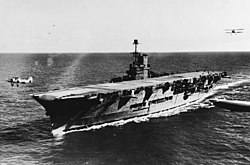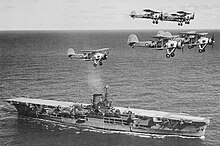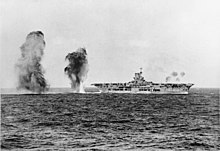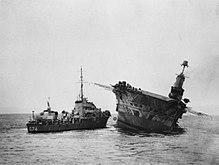HMS Ark Royal (91)
|
||||||||||||||||
|
||||||||||||||||
|
||||||||||||||||
|
||||||||||||||||
The HMS Ark Royal (91) was the Royal Navy's first modern aircraft carrier and a single ship . The carrier, put into service at the end of 1938, was torpedoed in the Mediterranean by the German submarine U 81 on November 13, 1941 and sank in tow off Gibraltar the following day .
technology
Fuselage and flight facilities
The hull of the carrier was 220 m long at the waterline, the greatest length was 244 m, the greatest width 28.8 m and the draft was 8.5 m. The flight deck was 18.3 m above the water. It displaced 22,000 tons empty. , fully loaded maximum 28,143 tn.l. The length-to-width ratio was 7.6: 1; Compared to other porters of his generation, the hull was shorter and wider ( Yorktown : 9: 1, Hiryū : 10: 1). This made the construction more manoeuvrable than its competition without any loss of seaworthiness. To save weight, most of the hull was welded.
The side armor was 114 mm thick. A flat torpedo bead with armor of 20 mm and a further bulkhead inside with 40 mm thickness protected especially against torpedoes . Magazines, tanks and machines were protected by an armored deck 89 mm thick at the level of the lower hangar deck. Protected in this way, the carrier was supposed to withstand 15.3 cm cannon fire at 6,400 m, bombs dropped below 2,000 m and the hit of a torpedo weighing 340 kg.
The unarmoured steel flight deck and the two hangar decks below were part of the hull . In the American and Japanese designs at the same time, the hangars were designed as superstructures. These stood on the main or belt deck (whereby they took up almost the entire deck area), while on the Ark Royal and its successors such as the Illustrious class, the flight deck formed the upper end of the fuselage. So the bug could also be executed completely closed. As large hangar openings were not required, greater structural stability was achieved.
At the same time, the possibilities of installing aircraft elevators in this supporting structure were limited, which is why they were relatively narrow: the two starboard elevators at the bow and stern were 6.70 m wide, the port elevator at the island level was 7.60 m. The wings of the aircraft had to be folded up.
The elevators had two platforms, the lower one could bring aircraft from the workshops in the lower hangar to the upper hangar deck, the second one from this deck to the flight deck. Transporting an aircraft to the workshops for repairs was therefore time-consuming and cumbersome.
The hangars had steel fire protection doors, salt water sprinkler systems and air locks to prevent explosive gases from escaping from the hangar area. 386 t of fuel were carried in cylindrical tanks for refueling the aircraft group. The tanks were decoupled from the hull so as not to be damaged when the hull moved as a result of an explosion.
The front area of the flight deck had an aerodynamically rounded deck edge with a semicircular floor plan. The long, sloping overhang at the stern could not be used as a landing area, but, like the bow shape, corresponded to aerodynamic considerations to improve the airflow over deck.
drive
The drive was carried out by three Parsons - geared turbines with a total of 103,000 shaft horsepower performance that appeared in three waves. The steam for the turbines was generated in six three-tube Admiralty-Yarrow boilers. The maximum speed of the carrier was 31.7 knots , the range with the 4,250 tons of bunker oil was 6,600 nautical miles at 15 knots. In order to guarantee the respective wind speeds above deck, the machines were designed for abrupt braking and acceleration maneuvers.
The exhaust gases were led into a large chimney in the island structure. The island and chimney had a favorable, streamlined curvature on the inside, similar to a wing, in order to divert turbulent air and smoke from the landing area on deck to the outside.
The carrier's crew consisted of up to 1,600 seafarers.
Armament and aircraft group
For air defense the ship had 16 QF 4.5-inch guns, 42 2-pounder guns and 32 12.7-mm MG Browning M2 . The carrier's aircraft group consisted of a maximum of 60 aircraft; mostly Fairey Swordfish torpedo bombers and Hawker Osprey fighter planes were used, from 1940 the outdated biplane fighters were replaced by Fairey Fulmar and Blackburn Skua dive fighters.
history
background
For years after the First World War, the conservative Admiralty of the Royal Navy had neglected its aircraft carrier fleet in favor of battleships. The blockade attitude of the Royal Air Force did the rest to bring the Royal Navy behind other navies in the area of naval aviation, because it had control over the existing naval aviation. She always questioned the need for aircraft carriers; naval aviation was secondary to her, as was her equipment.
Rear Admiral Reginald Henderson, the new commander of the carrier fleet, who had been in command of the Furious during the First World War , was able, as a representative of a modern perspective, to force the re-establishment of the Fleet Air Arm under the control of the Navy and the construction of new aircraft carriers. The plans for the early 1930s envisaged five new large aircraft carriers, each for over 70 aircraft, to replace the carriers Argus , Eagle , Furious , Glorious and Courageous . The Washington Agreement and the London Fleet Agreement had to be observed by reducing their tonnage limits to 27,000 tn.l. sought to utilize as cheaply as possible for a single girder and the total girder tonnage. To reduce costs, they set themselves an upper limit of 22,000 tn.l. The 22,000 tn was also sought because England wanted to fix this tonnage as a limit in the 2nd London Treaty in 1935; what failed - an agreement was reached on 23,368 tn as the maximum value for aircraft carriers.
In 1934 the new carrier program and thus the construction of the Ark Royal was approved. The budget situation did not allow the contract to be awarded until 1935. The growing tensions in Europe subsequently accelerated the construction of new carriers ( Illustrious and Victorious ).
Planning and construction
The Ark Royal as the sixth aircraft carrier of the Royal Navy was planned as such from the beginning, in contrast to most of the previous ships , which were still laid down as cruisers or battleships and were only modified during the construction period. Only the Hermes had been planned and built as an aircraft carrier before it. The keel laying of the Ark Royal took place on September 16, 1935 at Cammell Laird in Birkenhead . The launch took place on April 13, 1937 after a year and a half of construction. Originally the name Mercury was intended for the ship , then the Royal Navy decided to rename the aircraft mother ship Ark Royal , built during the First World War, to Pegasus in order to use the traditional name for the new carrier.
The commissioning took place on November 16, 1938 under Captain AJ Power, the equipment work was finally completed a month later. The construction costs amounted to a total of 2,330,000 pounds sterling .
commitment
Atlantic
By January 1939, the Ark Royal was extensively tested for its seaworthiness in the mouth of the Clyde ; This was followed by the maiden voyage, which took her to the Mediterranean , where she visited Valletta and took part in an exercise with the Glorious . In late March, the Ark Royal returned to Great Britain, where they undertook further maneuvers off the coast over the summer to increase operational readiness. On August 31, under the influence of the looming war, the carrier set out with the British Home Fleet to patrol the waters between Norway and the Shetland Islands .
The first contact with the enemy took place on September 14th when the Ark Royal was torpedoed by the German submarine U 39 . But because the torpedoes failed, the carrier was able to escape undamaged. The German submarine was later brought up and sunk by the carrier's escort destroyers. On the same day, Ark Royal dive bombers attacked the German submarine U 30 , but it escaped.
Twelve days later, the British submarine Spearfish was attacked by a German Dornier Do 18 flying boat. Ark Royal aircraft of the Blackburn Skua type , which came to the aid of the stranded submarine, shot down the German flying boat and thus achieved the first British aerial victory in World War II. Since the reconnaissance aircraft was able to send a message to the German fleet command, the carrier was attacked in the afternoon by Heinkel He 111 bombers with 2,000 kg bombs; however, the bombs missed the ship by several meters. Nevertheless, German propaganda reported the sinking of the Ark Royal .
After returning to Scapa Flow at the end of September, the carrier was assigned to "Force K", which set sail for the South Atlantic on October 2 to take part in the hunt for the German armored ship Admiral Graf Spee . After the self-sinking of the Admiral Graf Spee on December 17th, of which the crew of the Ark Royal learned in the port of Rio de Janeiro , she returned to England via Freetown, where she arrived on February 15, 1940. The next mission took the carrier together with the Glorious to the Mediterranean, where they called Alexandria . After the German occupation of Norway , the two aircraft carriers were first ordered to Gibraltar on April 10 and from there back to Scapa Flow, from where the two ships sailed to the Norwegian coast on April 23 in support of the British counterattack. After returning to Scapa Flow at the end of May, 15 Blackburn Skua of the Ark Royal attacked the battleship Scharnhorst in Trondheim on June 13th , eight machines were shot down by German flak and hunters.
Mediterranean Sea
After another short stay at the Orkney Islands, the Ark Royal ran to Gibraltar on June 18, where it joined the " Force H " and from now on operated in the Mediterranean. On July 3, she was involved in Operation Catapult , the sinking of the French fleet in the port of Mers-el-Kébir . Six days later, the ship was attacked by four Savoia-Marchetti SM.79s , which dropped over 100 bombs on the carrier, but did not hit them. On August 2, twelve Ark Swordfish launched an air strike on port facilities in Cagliari , Sardinia , and two planes did not return. Two more air raids on Cagliari followed in early September. At the end of September, the carrier was involved in attacks on the French fleet in Dakar , after which it returned to Great Britain for overhaul.
After returning to the Mediterranean Sea at the beginning of November, Ark Royal planes again launched air strikes on targets in Sardinia, and at the end of November they supported Force H during the naval battle at Cape Teulada . Torpedo bombers of the carrier flew two attacks on the Italian battleships, the Ark Royal itself got into a bombing attack by Italian SM.79 bombers, which however again failed. In January 1941, the porter was part of a large convoy that left Gibraltar for Malta to supply the besieged island. On February 2, Ark Royal Swordfish bombers attacked a dam in Italy, followed a week later by air strikes on Genoa, Spezia, Pisa and Livorno.
Hunt for the Bismarck
In mid-February 1941, the Ark Royal ran again into the Atlantic, where it secured convoys until the end of March. On March 20, a Fulmar scout sighted the German battleships Scharnhorst and Gneisenau ; Due to the great distance, however, no air attacks could be launched, so that the German ships could call at Brest on March 22nd without being disturbed.
On May 24th, the Ark Royal left Gibraltar with the Force H, reinforced by the Renown and Sheffield . Two days later, Swordfish torpedo bombers attacked the Bismarck , which had previously been spotted by a Catalina maritime patrol aircraft . At 3:50 p.m., a squadron consisting of 15 torpedo bombers, which had started an hour earlier from the Ark Royal, spotted a ship and attacked it with torpedoes. It was not the Bismarck , however , but the cruiser Sheffield that had been sent ahead of the fleet. Fortunately for the British, two of the torpedoes exploded as soon as they hit the water, while the cruiser was able to avoid three others. At 7.15 p.m., another group of 15 Swordfish took off from the deck of the carrier, they attacked the Bismarck at 20:47 p.m. and dropped their torpedoes. A torpedo hit and destroyed the steering system of the German battleship.
The following day, Swordfish bombers took off again to attack the Bismarck , which at that time was already under attack by British forces under Admiral Tovey. Due to the heavy fire of the British ships, however, the planes could not approach their destination and returned to the Ark Royal . The Bismarck sank at 10:40 a.m.
Two days later, the carrier returned to Gibraltar to resume operations in the Mediterranean.
Downfall
On the way back from Malta, the Ark Royal was sighted by the German submarine U 81 on November 13th and attacked with four torpedoes around three thirty in the afternoon. A torpedo hit the carrier amidships under the island. Within a short time had Ark Royal ten degrees list to starboard , this increased further. A large part of the crew was taken up by the destroyers Legion and Laforey , 250 men and the captain remained on board to save the ship, which was now being towed to Gibraltar. In the early morning of November 14, however, the list widened to 27 degrees, and the last of the crew left the ship at 04:30, which capsized and sank at 06:13, 14 hours after it was torpedoed. Only one crew member of the Ark Royal was killed.
Trivia
According to legend, the sinking of the Ark Royal was the third sunk workplace for the ship's cat Unsinkable Sam within six months. Before that, it had survived the sinking of the Bismarck and the Cossack . As a result, she was no longer taken on a ship.
A diving crew appointed by the BBC found the carrier on December 19, 2002 at a depth of 3500 ft. (Approx. 1200 m) approximately 30 miles from Gibraltar.
See also
literature
- Mike Rossiter: "Ark Royal": Sailing into Glory . Bantam Press, London 2006. ISBN 0-593-05551-9
Web links
- HMS Ark Royal (English)
Footnotes
- ↑ a b Seekrieg im Bild , Motorbuch Verlag, 5th edition, 1992, ISBN 3-87943-742-4 , p. 98, note on Figure 6.2 by David Brown.
- ↑ a b c d kbismarck.com , as of August 11, 2007
- ↑ Jordan: Aircraft Carrier - From the Beginnings to Today , Tosa Verlag, Vienna 2002, ISBN 3-85492-640-5 . P. 24
- ↑ a b c The history of the aircraft carrier from the First World War to the present day , Karl Müller Verlag, ISBN 3-86070-814-7 , p. 48
- ↑ Warships from 1900 to today . Buch und Zeit Verlagsgesellschaft mbH, Cologne 1979, p. 20-21 .
- ↑ a b Jordan: Aircraft Carrier - From the Beginnings to Today. P. 28f





